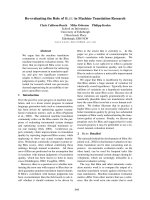Evaluating the potential for reverse innovation in brict countries: A panel data analysis
Bạn đang xem bản rút gọn của tài liệu. Xem và tải ngay bản đầy đủ của tài liệu tại đây (420.96 KB, 9 trang )
Journal of Applied Finance & Banking, vol. 5, no. 5, 2015, 125-133
ISSN: 1792-6580 (print version), 1792-6599 (online)
Scienpress Ltd, 2015
Evaluating the Potential for Reverse Innovation in BRICT Countries: A Panel Data Analysis
Nazan Yelkikalan1 and Erdal Aydın2
Abstract
A reverse innovation or trickle-up innovation is a term referring to an innovation which is
likely to be adopted first in the developing world. Reverse innovation is required to be
decentralized and focus to local-market. Innovation still originated with home-country
needs, but products and services were later modified to win in each market. To meet the
budgets of customers in poor countries, they sometimes de-featured existing products. From
this point of view, multinationals complete the reverse innovation process by taking the
innovations originally chartered for poor countries, adapting them, and scaling them up for
worldwide use. In this study, we investigate the impact of reverse innovation on human
development. To do this, we used the one-way fixed effect panel data technique. We
concluded that increases in the number of researcher, the number of article and research
and development expenditure % of GDP have a significantly positively impact on the
BRIC-T countries’ the Human Development Index. When analyzing the effects of resident
patent applications and nonresident patent applications on education for the selected
countries, we found that resident patent applications negatively affect education but
nonresident patent applications positively affect it.
JEL classification numbers: C33, O30, I20
Keywords: Panel data analysis, Reverse innovation, Trickle-up innovation, Education,
BRIC and Turkey
Çanakkale Onsekiz Mart University, School of Applied Sciences at Biga, Çanakkale, Turkey.
Çanakkale Onsekiz Mart University, Faculty Of Economics And Administrative Science at Biga,
Çanakkale, Turkey.
1
2
Article Info: Received : May 12, 2015. Revised : June 3, 2015.
Published online : September 1, 2015
Nazan Yelkikalan and Erdal Aydın
126
1
Introduction
The concept of reverse innovation was first expressed by Immelt et al. in October 2009 in
the study “How GE is disrupting itself”. Innovations are typically introduced in developed
economies and then they are seen in the developing world. On the contrary, A reverse
innovation is regarded as any innovation that is adopted first in the developing world.
Reverse innovations reach developed world following its introduction in the developing
ones. Several studies in the literature also define them as Gandhian or Frugal innovations
[1,2] In other words, it is a known fact that multinational companies continue their research
and development initiatives in the developed world and sell their newly invented products
in poor countries. Reverse innovation is doing exactly the opposite. Reverse innovation is
about innovating in poor countries and selling those products in rich countries. The issue
of reverse innovation comes fore among others since two-thirds of world’s growth in gross
domestic product (GDP) comes from poor countries [3].
Glocalization, the localization of global designs has sustained the expected results in the
past 30 years. This strategy will not last forever due to the change of the path that the
economic growth pursues. Because the epicenter of the global growth seems to be moving
from the developed economies to the emerging ones, reverse innovation could be counted
as the key factor in the next wave of global growth and product portfolio management [4].
The rise of emerging economies and globalization changed the location of innovative
activities to some extent. China and India two leading countries contribute to innovative
activities. These countries with their insufficient resources no longer adopt innovations of
developed countries origin but they also provide innovations themselves from time to time
[5].
Developing countries also known as the BRIC consists of Brazil, Russia, India and China.
This concept was first introduced by Jim O’Neill for the first time in his article titled as
“Building Better Global Economic BRICs” [6]. In his article O’Neil stressed the importance
of these economies and the role that they could play in the 21st century. However, following
years witnessed downturns in the economies of mentioned economies except for the China
and therefore the author proposed the MINT countries (Mexico, Indonesia, Nigeria and
Turkey) as an alternative to the BRIC economies [7].
The concept of BRIC has recently been used to signify the economic power that changes
its course from G7 countries to developing countries (The Symbol of Changing Balance:
BRIC”, Access Date: 20.11.2014). As stated in the National Innovation Index Report 2013
published by CASTED (Chinese Academy of Science and Technology for Development)
China has demonstrated a straight upwards direction in its innovative activities in the index.
China ranked 19 among other countries. The number of total countries that are listed in the
index is 40 [8]:
1- Innovative capacity of the country is the highest among BRIC countries.
2- Knowledge creation ability of China is very high.
3- An approach based on innovativeness and sustainability have been adopted by Chinese
Businesses.
4- China’s innovative capacity is still limited compared to developed countries.
BRIC countries can not be ignored when the figures they constitute are taken into
consideration. These countries encompass 42 percent of the world’s population and 1/3 of
the land. Their GDP and economic growth levels record high grades in the past years [9].
China became the second largest economy behind US in dollar PPP terms and surpassed
Evaluating the Potential for Reverse Innovation in BRIC-T Countries
127
Japan in this field. However other BRIC countries, Brazil, Russian Federation and India
were behind the developed economies of Japan, Germany France and United Kingdom.
When the table is observed it can be said the next study will be about MINT countries.
Table 1: Country Rankings from Gross Domestic Product (GDP) 2013
Ranking
Economy
Millions of US Dollars
1
United States
16.768.100
2
China
9.240.270
3
Japan
4.919.563
4
Germany
3.730.261
5
France
2.806.428
6
United Kingdom
2.678.455
7
Brazil
2.245.673
8
Italy
2.149.485
9
Russian Federation
2.096.777
10
India
1.876.797
11
Canada
1.826.769
12
Australia
1.560.372
13
Spain
1.393.040
14
Korea, Rep.
1.304.554
15
Mexico
1.260.915
16
Indenosia
868.346
17
Netherlands
853.539
18
Turkey
822.135
19
Saudi Arabia
748.450
20
Switzerland
685.434
Source: World Development Indicators database, World Bank [19], 16 December 2014
Table 1 shows the country rankings based on GDP in 2013. The United States is the first
country on the list with its 16 billion 768 million USD GDP. Following the USA, China is
the second country with its 9 billion 240 million USD. Japan, Germany, France and UK are
the followers of China. Brazil as another BRIC country recorded the amount of 2 billion
096 million USD. Following Brazil Italy is the 8th country and then Russian Federation
and India constitute the 9th and 10th countries on the list. Turkey is at the 18th place on the
list.
Turkey is among 20 largest economies in the world and it ranks number 18th on the list. If
the country sustains its economic growth levels it will be using 2.3% of the planet’s
resources in 2050. In addition, forecasts suggest that E7 countries (Turkey, China,
Indonesia, India, Russia, Mexico and Brazil) will probably surpass G7 economies (the USA,
Germany Japan, Italy, France, Canada and the UK) with respect to their economic growth
by 2032 [10].
Nazan Yelkikalan and Erdal Aydın
128
2
Data, Model and Estimation Procedure
2.1 Data and Model
In this study, we investigate the impact of reverse innovation on human development. For
this purpose, the equation (1) and the equation (2) are estimated through the one -way fixed
effects estimator.
log hdiit 1 i 1.log patent _ ratioit 2 .log researcherit 1 3 .log rdit 1 4 .log articleit 1 uit
(1)
log hdiit 1 i 1.log nonpatent _ ratioit 2 .log researcherit 1 3.log rdit 1 4 .log articleit 1 eit
(2)
We used the human development index, as a proxy variable of education (hdi). The Human
Development Index (HDI) is a summary measure of average achievement in key
dimensions of human development: a long and healthy life, education, being
knowledgeable and have a decent standard of living. The HDI is the geometric mean of
normalized indices for each of the three dimensions. In addition, we used the share of
resident patent applications in total patent applications (patent_ratio), the share of
nonresidents patent applications in total patent applications (nonpatent_ratio), the number
of researchers in Research and Development (researchers), the number of article in
Scientific and technical journals (article) and research-development expenditure % of GDP
(rd) as independent variables in this study. All variables are specified in logarithmic form
and in their first-order differenced in order to obtain stationary variables. Data are gathered
on yearly basis from 2001 to 2012 of BRIC-T countries3. All data are taken from World
Bank. Also in order to carry out the paper E views 8.0 is used.
Table 1 shows some descriptive statistics for the data set. As a result, there is no sampling
bias in the data. The means of all variables used for the empirical analysis are close neither
to their minimum nor maximum value, which indicates that there is no disproportion.
Moreover, the standard deviations of the variables are widely dispersed around the mean.
Table 2: Descriptive Statistics of Selected Variables
total
rd
article researcher patent nonpatent
0.985755 19087.56 1071.733 59003.89 23605.03
Mean
0.984720 13500.40 621.6779 28649.00 13778.00
Median
Maximum 1.836170 89894.40 3460.198 526412.0 110583.0
(China)
(China)
(Russia)
(China)
(China)
(country)
Minimum 0.479090 3484.100 111.2350 837.0000 160.0000
(Turkey) (Turkey) (India)
(Turkey) (Turkey)
(country)
0.301638 18530.70 1123.181 100602.5 28192.94
Std. Dev.
hdi
patent
35398.85 0.664431
4721.000 0.686000
415829.0 0.777000
(China)
(Russia)
277.0000 0.483000
(Turkey) (India)
75175.36 0.084269
In order to estimate the equation (1) and the equation (2), we used the one-way fixed effect
panel data technique. According to Baltagi [11], panel data technique that is used in
empirical section of the study has some the advantages. These advantages can be
summarized as: i) Panel data are able to control the heterogeneity that occurs among
3
The countries consist of Brazil, Russian Federation, India, China and Turkey.
Evaluating the Potential for Reverse Innovation in BRIC-T Countries
129
individuals, firms, states or countries whereas time-series and cross-section studies do not
control the heterogeneity for these units. ii) Panel data give more informative data, more
variability, less co-linearity among the variables, more degrees of freedom and so, more
efficiency. iii) Panel data are relatively more suitable about the dynamics of adjustment
than other techniques. iiii) Panel data model is better able to study more complicated
behavioral models that pure time-series or pure cross-section models cannot study [12].
2.2 Estimation Procedure
2.2.1 Panel Unit Root Tests
Firstly, we test the stationarity of the selected series included in the regression model in
order to obtain unbiased estimations. In this sense, we use the panel-based unit root tests of
Levin, Lin and Chu [13] and Im, Pesaran and Shin [14].
A first generation of models has analyzed the properties of panel-based unit root tests under
the assumption that the data is independent and identically distributed (i.i.d) across
individuals.
In general, this type of panel unit root tests is based on the following regression:
Yi ,t i .Yi ,t 1 Zi ,t . ui ,t
(3)
where i = 1,2,…,N is individual, for each individual; T=1,2,…,T time series observations
are available, Z i ,t is deterministic component and ui ,t is error term. The null hypothesis of
this type is i =0 for i . The first of first generation panel unit root tests is LLC that
allow for heterogeneity of individual deterministic effects and heterogeneous serial
correlation structure of the error terms assuming homogeneous first order autoregressive
parameters. They assume that both N and T tend to infinity but T increase at a faster rate,
so N/T 0. They assume that each individual time series contains a unit root against the
alternative hypothesis that each time series stationary. Thus, referring to the model (3), LLC
assume homogeneous autoregressive coefficients between individual, i.e. i for all
I, and test the null hypothesis H 0 : i 0 against the alternative H A : i
for all i. The structure of the LLC analysis may be specified as follows:
0
pj
Yi ,t i i .Yi ,t 1 i . ij .Yi ,t j uit
(4)
j 1
where i = 1,…, N t= 1,…,T is trend, i is individual effects, uit is assumed to be
independently distributed across individuals. LLC estimate to this regression using pooled
OLS. In this regression deterministic components are an important source of heterogeneity
since the coefficient of the lagged dependent variable is restricted to be homogeneous
across all units in the panel [15]. Other test, IPS test allows for residual serial correlation
and heterogeneity of the dynamics and error variances across units. Hypothesis of IPS may
be specified as follows [12]:
Nazan Yelkikalan and Erdal Aydın
130
H 0 : i 0
H A : i
0
for all i
The alternative hypothesis allows that for some (but not all) of individuals series to have
unit roots. IPS compute separate unit root tests for the N cross-section units. IPS define
their t-bar statistics as a simple average of the individual ADF statistics, ti, for the null as:
N
t ti / N
i 1
It is assumed that ti are i.i.d and have finite mean and variance and E( t i ), Var( t i ) is
computed using Monte-Carlo simulation technique.
2.2.2 Estimation
2.2.2.1 The-One Way Fixed Effects Model
According to Hsiao [16], a longitudinal, or panel, data analysis provides multiple
observation on each individual in the sample. Panel data sets for economic research have
numerous advantages over cross-sectional or time-series data sets. Firstly, panel data give
the researcher a large number of data points, increasing the degrees of freedom and reducing
the collinearity among independent variables. So, panel data improve the efficiency of
econometric estimates achieved. Secondly, panel data allow us to construct and analyze
more complicated behavioral models than conventional cross-sectional or time series data.
Besides these advantages, panel data provide the possibility of generating more accurate
predictions for individual outcomes than time-series data alone [16].
Panel data may have group effects, time effects, or both. These effects are either fixed effect
or random effect. A fixed effect model assumes differences in intercepts across groups or
time periods. Fixed effects model explore the relationship between the predictor and
outcome variables within an entity. This entity may be households, countries, firms. The
model assumes all other time invariant variables across entities that can influence the
predictor variables to be constant [17].
uit i t vit
i= 1,…,N
t=1,…,T
where i denotes the unobservable individual effect, t denotes the unobservable time
effect, and vit is the stochastic disturbance term. t is individual-invariant and it accounts
for any time-specific effect that is not included in the regression [11].
Fixed effects model can be formulated as [12]:
yit x'it . i it
(5)
where i denotes all the observable effects and it is group-specific constant term in the
regression model. i equals zi' . in the regression (5). If zi is unobserved, but
correlated with xit , then the coefficient of is biased and inconsistent under assumptions
of E (uit ) 0 ; E (u 2it ) 2 all i; E(uit .u jt s ) 0 for s 0 and i j
3 Empirical Results
Evaluating the Potential for Reverse Innovation in BRIC-T Countries
131
Table 2 presents the results of the panel unit root tests. According to Table 2, the results of
the panel unit root tests confirm that other data series, except for the variables of
nonpatent_ratio, are non-stationary at level while these series are stationary after taking
their first-differences.
Table 3: Panel Unit Root Test for the period 2001-2012
Constant
IPS
Variable
hdi
rd
researcher
article
patent_ratio
nonpatent_ratio
dhdi
drd
dresearcher
darticle
dpatent_ratio
Stat.
3.01510
0.75869
-1.28001
2.52940
0.89910
-10.7572***
-5.61882***
-3.00683***
-3.53865***
-2.20228**
-2.95439***
p-value
0.9987
0.5828
0.1003
0.9943
0.8157
0.0000
0.0000
0.0013
0.0002
0.0138
0.0016
LLC
Stat.
0.44655
0.20911
-2.70816***
2.72024
-0.41138
-10.5800***
-8.36540***
-4.11728***
-4.95492***
-4.88314***
-5.01784***
p-value
0.6724
0.5828
0.0034
0.9967
0.3404
0.0000
0.0000
0.0000
0.0000
0.0000
0.0000
d is the first difference operator. L is the logarithm of the variable. ***,** denote the
rejection of the null at the 1% and 5% levels respectively.
We use a specific country group (BRIC-T countries) in the study so fixed effect panel data
analysis is useful [18]. The results from the one-way fixed effects for the equation (1) and
the equation (2) are shown in Table 3 and Table 4, respectively.
Table 4: The Results for One-way Fixed Effects for the Equation 1
Dependent Variable: dhdi
Variable
C
dpatent_ratio
dresearcher
drd
darticle
Coefficient
-1.393804
-0.022311
0.040070
0.123860
0.072508
Std. Error
0.083555
0.003567
0.011474
0.018428
0.009158
t-Statistic
-16.68126
-6.255576***
3.492213***
6.721091***
7.917638***
Prob.
0.0000
0.0000
0.0010
0.0000
0.0000
d is the first difference operator. It was taken natural log of data of all variables. *** and**
indicate the statistical significance at 1% and 5% levels respectively.
Table 5: The Results for One-way Fixed Effects for the Equation 2
Dependent Variable: dhdi
Variable
C
dnonpatent_ratio
dresearcher
drd
darticle
Coefficient
-1.204806
0.014544
0.031642
0.156238
0.062315
Std. Error
0.096588
0.004557
0.015431
0.018915
0.012802
t-Statistic
-12.47362
3.191796***
2.050527**
8.260141***
4.867592***
Prob.
0.0000
0.0024
0.0455
0.0000
0.0000
d is the first difference operator. It was taken natural log of data of all variables. *** and**
indicate the statistical significance at 1% and 5% levels respectively.
From Table 3 and Table 4, we can see that increases in the number of researcher, the number
of article and research and development expenditure % of GDP have a significantly
Nazan Yelkikalan and Erdal Aydın
132
positively impact on the BRIC-T countries’ the Human Development Index, used as a proxy
variable of education. When analyzing the effects of resident patent applications and
nonresident patent applications on education for the selected countries, we found that
resident patent applications negatively affect education but nonresident patent applications
positively affect it. Thus, we can say that nonresident patent applications, the number of
researcher, the number of technical and scientific article, research-development expenditure
% of GDP, which are used as innovation performance measurements provide a positive
contribution in reaching higher levels of education for BRIC-T countries.
References
[1]
[2]
[3]
[4]
[5]
[6]
[7]
[8]
[9]
[10]
[11]
[12]
[13]
[14]
V. Sehgal, K. Dehoff and G. Panneer (2010) “The Importance of Frugal Engineering.
Economic Times Mumbai”, Issue 59, 2010. In G. M. Ivan, D, H. Alfonso and G. C.
Esmeralda, “Application of Reverse Innovation in SMEs”, Book of Proceedings of
the 7th International Conference on Industrial Engineering and Industrial
Management, XVII Congreso de Ingenieria de Organizacion, pp.180-181.
Prahalad C.K., Mashelkar R.A. (2010) “Innovation's Holy Grail”, Harvard Business
Review July-August 2010 132-141. In G. M. Ivan, D, H. Alfonso and G. C. Esmeralda,
“Application of Reverse Innovation in SMEs”, Book of Proceedings of the 7th
International Conference on Industrial Engineering and Industrial Management, XVII
Congreso de Ingenieria de Organizacion, pp.180-181.
V. Govindarajan, “Reverse Innovation Starts with Education”, ,
November 18, 2013, Erişim Tarihi 26.11.2014.
N. Gautam. “Reverse Innovation – Enablers & Opportunities”,
www.autotechreview.com, January 2013, Volume 2, Issue 1, pp. 54.
V. Govindarajan and R. Ramamurti. “Reverse Innovation, Emerging Markets, and
Global Strategy”, Global Strategy Journal, 1: 191-205, 2011, pp. 191.
J. O’Neill, “Building Better Global Economic BRICs”, Global Economics Paper
No:66, November 2001.
J. Martinez, “Emerging Nations”, www.socsci.uci.edu, Erişim Tarihi: 20.11.2014.
Z. Ning, “China Science and Technology Newsletter”, Department of International
Cooperation Ministry of Science and Technology (MOST), P.R. China, No.11, June
10, 2014, pp.1-3.
P. Wennström, R. Gupte and I. Secches, “BRIC Market Innovation Strategies”,
AgroFOOD Industry Hi-Tech. May/June 2011, vol. 22, no. 3, pp. 8.
TUSIAD, “Vision 2050 Turkey Report”, />erişim tarihi 01.02.2015).
B. Baltagi, “Econometric Analysis of Panel Data”, Third Edition, Chichester: John
Wiley & Sons, Ltd., 2005.
M. Ener, C. Kılıç and F. Arıca. “The Effect of Total Petroleum Consumption on
Current Account Balance: An Application for Upper-Middle Countries”, International
Journal of Economy, Management and Social Sciences, 2(12) December 2013, pp.
996-1001.
A. Levin, C. Lin, and J. C. Chu. (2002), “Unit Root Tests in Panel Data: Asymptotic
and Finite-Sample Properties,” Journal of Econometrics 108, pp 1-24.
K.S. Im, M. H. Pesaran and Y. Shin. “Testing for Unit Roots in Heterogeneous
Panels”, Journal of Econometrics, 2003, 115, 53-74.
Evaluating the Potential for Reverse Innovation in BRIC-T Countries
133
[15] L. Barbieri. “Panel Unit Root Tests: A Review”, Quaderni del Dipartimento di
Scienze Economiche e Sociali. Serie Rossa, n.43, Università Cattolica del Sacro
Cuore, Piacenza, 2006.
[16] C. Hsiao. “Analysis Of Panel Data”, Cambridge: Cambridge University Pres, 2003.
[17] O. Torres-Reyna. “Panel Data Analysis: Fixed and Random Effects”,
2007.
[18] B. H. Baltagi. “Econometric Analysis of Panel Data”, 4th Ed., John Wiley & Sons,
Ltd., 2008.









